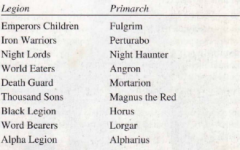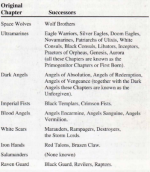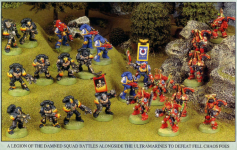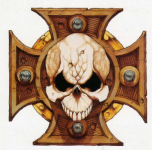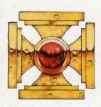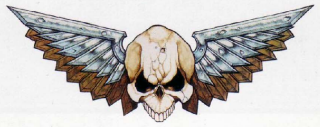THE SPACE MARINES
The origin of the Space Marines goes back to the distant days before the Imperium itself, to a time known to history as the Age of Strife. This was an age of wars and savagery throughout the galaxy. Interstellar civilisation all but collapsed leaving human planets isolated and vulnerable. It is impossible to say for certain what caused this great calamity, but one of the main contributory factors was the development of massive psychic storms within warp space. All interstellar travel relies upon unique drive systems which propel ships through the alternate psychic dimension of warp space. Sometimes fierce storms within the warp make journeys hazardous. Craft can be carried off course by thousands of parsecs or hundreds of years in time. If storms are sufficiently intense or lengthy it is impossible for ships to travel at all. Such adverse conditions prevailed throughout the long Age of Strife.
During the Age of Strife the Earth was devastated by pollution and plague. Its huge and largely unproductive population had come to rely upon imports of food and raw materials without which life on the planet could not be sustained. Billions died and the survivors fought savagely amongst themselves. From the ruins of civilisation emerged a barbaric society of warlords and warrior tribes. The accumulated accomplishments of millennia were forgotten. Earth’s cities fell into rubble and were soon lost beneath the drifting sands. Of a once proud and sophisticated society nothing remained. The Age of Strife lasted for approximately ten thousand years and ended only when the warp storms abated and interstellar travel became feasible once more. At that time a mighty leader emerged upon Earth, a warlord and conqueror who succeeded in uniting the entire planet under his rule. From the battling tribes of barbarians a new world was created. Ancient technologies were rediscovered and directed to new purposes. The name of the warlord who achieved all this is not recorded, and he is known only by the title he assumed in later times — the Emperor.
THE FIRST SPACE MARINES
A Space Marine is a genetically enhanced warrior, far stronger and tougher than an ordinary human being. Space Marines can live for several hundred years and they possess extraordinary powers.
Every Space Marine is born an ordinary human. The conversion into super-warrior is achieved by the careful implantation of genetically cultured organs. Once implanted into the human body, these organs gradually grow and modify the recipient’s genetic structure. Selected hormones are boosted to encourage extraordinary growth. Muscle tissues expand and the bone structure is strengthened. Genetically tailored substances released into the bloodstream cause further changes throughout the Space Marine’s body. This process takes several years to complete and only works whilst the body is growing naturally. This means that Space Marines are recruited at a comparatively young age and must start their training before they reach adulthood. Genetically altered warriors appeared in the Emperor’s armies even before he had completed the conquest of Earth. They were the first of their kind and as such their powers were less than the Space Marines of later years. None the less, during those early years the techniques of genetic restructuring were perfected. Individual germ cells, called gene-seeds, were isolated and genetically modified. From these few cells tiny organs were cultivated in a nutrient solution. Each organ would then be tested for genetic stability and surgically inserted into a warrior. This technique remains basically the same even in the forty-first millennium.
The development of genetic tissue took many centuries of work. This research was itself a spin-off from the aborted Primarch project, which was an early attempt at genetic restructuring with the aim of creating god-like creatures called Primarchs. The Primarchs were designed to have powers far beyond even the incredible abilities of the Space Marines. Samples of genetic tissue taken from the foetal Primarchs were used to create the genetic banks which provided the first Space Marine gene-seed. Thus the fates of Primarchs and Space Marines were inextricable interwoven even at their conception, and the Primarchs were to play a vital role in the early history of the Space Marines.
THE GREAT CRUSADE
The Great Crusade is the name given to the period of conquest that established the extent of the Imperium. During the Great Crusade massive armies of Space Marines spread out from Earth. Their task was to seek out and liberate human worlds throughout the galaxy, uniting all of humanity in a single mighty Imperium. The Great Crusade lasted for about two hundred years and saw some of the bloodiest fighting known up to those times. The worlds rediscovered by the Emperor’s armies had been cut off from Earth for millennia. Some had degenerated to barbarity. Others had developed into sprawling hive worlds. Many were under the domination of aliens or had become corrupted by the evils of Chaos. All these worlds were gradually reconquered and brought back within the Imperium.
The Space Marines who took part in the Great Crusade were organised into massive armies called Legions. The size of a Legion varied tremendously and could be expanded to provide extra troops as needed. Accelerated gene-seed germination techniques were developed that could turn a human into a Space Marine within a year. At the time, tens of thousands of troops were needed so the Space Marine Legions could push forwards over a widening battle front. Only later would the stability of this accelerated gene-seed prove doubtful when the dangers of its use became apparent.
Twenty Space Marine Legions took part in the Great Crusade. These twenty are known as the First Founding because they were the first Space Marines to be created. Each Legion was led by its own Primarch, the god-like being whose genetic structure formed the basis for the Legion’s gene-seed. The character and special powers of each Primarch were reflected in the abilities of his Space Marine Legion. Even today the descendants of these ancient Space Marines are characterised by genetic qualities derived from their original Primarchs. The twenty original Chapters and their Primarchs were as follows.
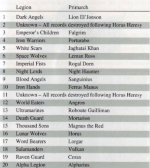
These twenty Legions conquered the galaxy and created the Imperium. Later, during the Horus Heresy, they divided into two factions and fought for possession of the empire.
The origin of the Space Marines goes back to the distant days before the Imperium itself, to a time known to history as the Age of Strife. This was an age of wars and savagery throughout the galaxy. Interstellar civilisation all but collapsed leaving human planets isolated and vulnerable. It is impossible to say for certain what caused this great calamity, but one of the main contributory factors was the development of massive psychic storms within warp space. All interstellar travel relies upon unique drive systems which propel ships through the alternate psychic dimension of warp space. Sometimes fierce storms within the warp make journeys hazardous. Craft can be carried off course by thousands of parsecs or hundreds of years in time. If storms are sufficiently intense or lengthy it is impossible for ships to travel at all. Such adverse conditions prevailed throughout the long Age of Strife.
During the Age of Strife the Earth was devastated by pollution and plague. Its huge and largely unproductive population had come to rely upon imports of food and raw materials without which life on the planet could not be sustained. Billions died and the survivors fought savagely amongst themselves. From the ruins of civilisation emerged a barbaric society of warlords and warrior tribes. The accumulated accomplishments of millennia were forgotten. Earth’s cities fell into rubble and were soon lost beneath the drifting sands. Of a once proud and sophisticated society nothing remained. The Age of Strife lasted for approximately ten thousand years and ended only when the warp storms abated and interstellar travel became feasible once more. At that time a mighty leader emerged upon Earth, a warlord and conqueror who succeeded in uniting the entire planet under his rule. From the battling tribes of barbarians a new world was created. Ancient technologies were rediscovered and directed to new purposes. The name of the warlord who achieved all this is not recorded, and he is known only by the title he assumed in later times — the Emperor.
THE FIRST SPACE MARINES
A Space Marine is a genetically enhanced warrior, far stronger and tougher than an ordinary human being. Space Marines can live for several hundred years and they possess extraordinary powers.
Every Space Marine is born an ordinary human. The conversion into super-warrior is achieved by the careful implantation of genetically cultured organs. Once implanted into the human body, these organs gradually grow and modify the recipient’s genetic structure. Selected hormones are boosted to encourage extraordinary growth. Muscle tissues expand and the bone structure is strengthened. Genetically tailored substances released into the bloodstream cause further changes throughout the Space Marine’s body. This process takes several years to complete and only works whilst the body is growing naturally. This means that Space Marines are recruited at a comparatively young age and must start their training before they reach adulthood. Genetically altered warriors appeared in the Emperor’s armies even before he had completed the conquest of Earth. They were the first of their kind and as such their powers were less than the Space Marines of later years. None the less, during those early years the techniques of genetic restructuring were perfected. Individual germ cells, called gene-seeds, were isolated and genetically modified. From these few cells tiny organs were cultivated in a nutrient solution. Each organ would then be tested for genetic stability and surgically inserted into a warrior. This technique remains basically the same even in the forty-first millennium.
The development of genetic tissue took many centuries of work. This research was itself a spin-off from the aborted Primarch project, which was an early attempt at genetic restructuring with the aim of creating god-like creatures called Primarchs. The Primarchs were designed to have powers far beyond even the incredible abilities of the Space Marines. Samples of genetic tissue taken from the foetal Primarchs were used to create the genetic banks which provided the first Space Marine gene-seed. Thus the fates of Primarchs and Space Marines were inextricable interwoven even at their conception, and the Primarchs were to play a vital role in the early history of the Space Marines.
THE GREAT CRUSADE
The Great Crusade is the name given to the period of conquest that established the extent of the Imperium. During the Great Crusade massive armies of Space Marines spread out from Earth. Their task was to seek out and liberate human worlds throughout the galaxy, uniting all of humanity in a single mighty Imperium. The Great Crusade lasted for about two hundred years and saw some of the bloodiest fighting known up to those times. The worlds rediscovered by the Emperor’s armies had been cut off from Earth for millennia. Some had degenerated to barbarity. Others had developed into sprawling hive worlds. Many were under the domination of aliens or had become corrupted by the evils of Chaos. All these worlds were gradually reconquered and brought back within the Imperium.
The Space Marines who took part in the Great Crusade were organised into massive armies called Legions. The size of a Legion varied tremendously and could be expanded to provide extra troops as needed. Accelerated gene-seed germination techniques were developed that could turn a human into a Space Marine within a year. At the time, tens of thousands of troops were needed so the Space Marine Legions could push forwards over a widening battle front. Only later would the stability of this accelerated gene-seed prove doubtful when the dangers of its use became apparent.
Twenty Space Marine Legions took part in the Great Crusade. These twenty are known as the First Founding because they were the first Space Marines to be created. Each Legion was led by its own Primarch, the god-like being whose genetic structure formed the basis for the Legion’s gene-seed. The character and special powers of each Primarch were reflected in the abilities of his Space Marine Legion. Even today the descendants of these ancient Space Marines are characterised by genetic qualities derived from their original Primarchs. The twenty original Chapters and their Primarchs were as follows.

These twenty Legions conquered the galaxy and created the Imperium. Later, during the Horus Heresy, they divided into two factions and fought for possession of the empire.



